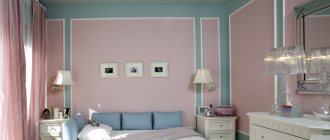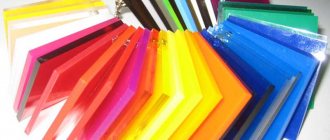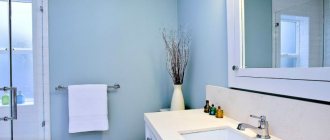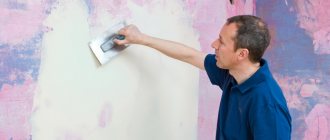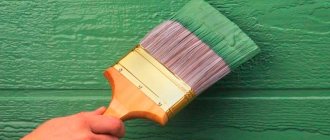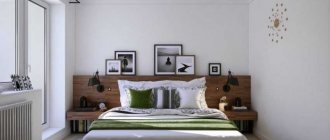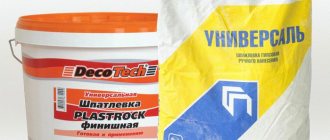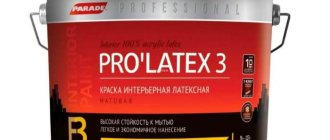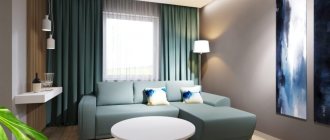The geometry of the wall surface is a real problem in apartments. Nowadays, a fairly popular finishing method is painting. Today we will learn how to paint uneven walls correctly so that they look almost flawless.
As it turns out, you can solve the problem yourself if you follow the algorithms and follow the recommendations of experts.
You don't have to spend a lot of time and effort on the labor-intensive alignment process. Ultimately, painting uneven walls directly will make them visually appealing. All the best techniques, proven tips in our material. Painting uneven walls with your own hands will allow you to mask bulges and depressions, cracks, and all kinds of surface defects.
How to paint a surface with uneven surfaces in an apartment?
Painting walls with uneven surfaces has its own specifics. The main purpose of such decoration is to visually smooth out existing depressions, bulges, and other defects.
Preparation
Before painting the walls in the apartment, it is necessary to prepare the surface for applying future decor. To do this, you need to remove the remnants of the previous finish.
If wallpaper was previously pasted, you need to get rid of it. Just spray them with water from a spray bottle, wait a little - they will come off easily. The old layer of paint also needs to be cleaned. Water-based compositions must be moistened with water. The wet layer can be easily cleaned off with a spatula. Oil-based compounds are removed in one of three ways:
How to do this without alignment?
Painting walls without leveling means that the labor-intensive stage of work to bring their surface to perfection will be skipped.
This is true, but something still needs to be done. To make a painted wall look good, you will need to align the corners of the room. This is the detail that catches your eye. You will also need to get rid of large cracks. If this is not done, they will be noticeable both under wallpaper and after painting. Don't forget about priming - it will significantly improve the structure of the base, the paint will lie smoother, and the wallpaper will adhere well.
Below are the most popular ways to finish walls without leveling.
Texture paint
When painting walls, the following problem often arises: flaws, defects, and unevenness can disrupt the integrity of the decorative coating, and subsequently it can crack. This difficulty can be corrected through proper selection of materials for construction.
Texture paint is a group of building materials combined into a single whole: a mixture of water-dispersion paint with special fillers containing large particles (their size is about 50 microns). This composition provides an increased level of viscosity of the paint composition, so the paint coating can be used to form a coating with a relief texture. At your choice, it can be an imitation of strokes and waves, tree rings, natural stone and fabric.
A variety of colors is achieved by adding pigment of different intensities, and a variety of textures is achieved by adding certain fillers. Advantages of texture paints over traditional types:
Walls with uneven surfaces can be covered with paintable wallpaper. Not every wallpaper can visually smooth out defects. Popular options for problematic surfaces:
Experts advise choosing the thickest, densest and most textured wallpaper possible for surfaces with defects. Before wallpapering, minimal surface preparation is still necessary. Seal all cracks, remove dust and dirt, then cover the surface with a primer solution, preferably 2 layers. After the soil has dried, you can begin gluing wallpaper for further painting.
You can choose any paint color for the wallpaper. Matte shades hide unevenness better, while glossy shades can, on the contrary, make them more noticeable.
Playing with color
The aesthetics of walls and ceilings can also be improved by using colored cut-outs, that is, paint strips of a different color. They will not only visually level the surface, but also decorate it. We can place them below the ceiling line, in the corners of the wall or anywhere else. However, in order for them to fulfill their purpose, they must be executed correctly. How to do it?
First of all, we must measure the belt line. Once the correct location has been found, a level should be used. It’s just better to choose not a regular one, but a laser one. Thanks to this device, you can effectively and conveniently determine all the necessary lines that will define the boundary between two colors.
Again we will need masking tape. We attach it along predetermined boundaries. However, before we do this, we must clean the wall thoroughly. Any dirt or dust will prevent the tape from sticking to the surface, causing the paint underneath to fall off.
Also, let's remember that the wall on which we paste the tape must be dry. So if we painted it just before we made the cuts, let's wait until it's completely dry. The time required for this is usually indicated by the manufacturer on the paint packaging.
When applying tape, do not attach it too tightly to the wall - this may cause the paint to fall off when it peels off. Only the edge of the tape on which the paint will be applied should be completely tight.
Styles
Designer decoration of apartments offers dozens of different styles. Among them there are those who will help turn existing disadvantages into advantages.
Rough industrial style does not imply that the walls of the room will be perfectly smooth. Deliberate carelessness of finishing is what is inherent in this direction. The rough structure of concrete or uneven brickwork will look appropriate in such an interior.
Dyeing in dark colors
Ombre technique
This type of coloring has long crossed the threshold of beauty salons. It is even used in clothing design, creating spectacular interiors. Gradation of shades of the same color with a transition from saturated to blurry will help decorate surfaces with flaws.
Painting problem walls without prior leveling is a difficult and exciting task at the same time. After studying the advice of professionals, you need to choose the type of wall covering - wallpaper or special paint. Don’t be afraid to experiment: sometimes a non-trivial approach leads to amazing results , because you can create an attractive and original home interior.
Source
Decorative painting of walls: choose the color and texture to match the style of the room
We will send the material by email
Decorative painting of walls is considered a modern option for finishing the interior of a house. There are many varieties of material, as well as design options. For each room you can use different surface covering ideas.
How to hide unevenness on the walls?
What materials to choose and how to hide obvious curvature without leveling the walls. The easiest way to hide uneven walls is to cover them with wallpaper. A wall prepared for wallpaper does not need to be perfectly smooth compared to a wall for painting.
Interesting materials:
How to make a temporary registration for public services? How to make a temporary registration without the presence of the person being registered? How to make temporary registration locally? How to make temporary registration in the Russian Federation? How to make a pop-up taskbar? How to make a second screen on your phone? How to make a second bathroom? How to make a second slide in powerpoint? How to make a second passport based on the current one? How to make a second work book?
Pros and cons of painted walls
It is believed that painting walls will be durable. In addition, this finish does not require special care. Simply wipe the surface with a damp cloth and it is clean again. Before using paint, you need to weigh all the advantages and disadvantages. The advantages of painted walls include:
Disadvantages include the need to prepare walls for painting. Textured copies are very expensive. If the coating is done incorrectly, the paint begins to deteriorate.
On a note! Glossy paint practically does not absorb dust, so it looks attractive and natural longer than matte.
Water-based
This type of paint is sold at a low cost and is the cheapest compared to other existing types of coatings. It uses plain water as a solvent, for this reason there is almost no smell, and it does not take much time to dry completely.
The production of water-based paint is carried out mainly from PVA or acrylic resins. It does not absorb dirt and is easily washed off. However, it is forbidden to use it in rooms with high levels of moisture.
19 simple and original ideas to paint walls in an unusual way
Decorating the walls of a house can be very diverse. It is important to take into account the functionality of the room and its size when tiling. There are several popular options that are suitable for large and small living spaces.
Creating an Accent Wall
An excellent composition that can be seen on the bedroom wall. This design is suitable for vintage and modern interiors. The dark purple base goes well with orange, lilac and burgundy shades in a geometric pattern. Placing a picture on two walls makes the room visually wider. Proper coloring and clear lines create a 3D effect. The finishing motifs are repeated in other interior features.
Rich texture for next to nothing
If you have unattended newspapers lying around at home, they will come in handy during painting. It is important to first prepare a color base, and then choose a darker or lighter shade. With the help of crumpled newspaper, a very effective and remarkable structure is obtained. It is rational to choose warm or neutral tones for this purpose.
Great idea with the rag.
In order not to involve craftsmen in creating decorative painting, you can use improvised means. Paint a section of the wall in a random manner. Then roll and twist a small piece of fabric (an old pillowcase or towel will do). Go over the wet paint, pressing and tearing the fabric.
Using a broom or comb
You can create an unusual pattern on the walls using an old comb or broom. It is better to paint the walls in fragments so that the coating does not have time to dry. Place the comb against the painted wall and make a semicircle. With a clean broom you can make oblong stripes. In this way, they create an imitation of a chessboard, alternating horizontal stripes with vertical ones.
Imitation brickwork
To implement this idea, you will need a large kitchen sponge and mounting tape. The distance between the “bricks” can be calculated individually. Usually this is no more than 3-5 mm. It is better to organize these seams using mounting tape, cutting out thin strips. You can make a pattern using a template. To do this, the surface is first prepared. To paint, just dip a sponge lightly into the paint and apply it to the wall. Just don’t need to saturate the foam with the material. This may cause drips.
Tree in your room
This pattern will be interesting in a children's room or bedroom. You can paint the main part of the surface with a dark shade, for example, turquoise, and make the wood white. If you have artistic skills, you can draw it yourself. Otherwise, you will have to limit yourself to a ready-made template.
You can use this design for a bright living room or dining room. A red cherry blossom pattern is created on a beige wall. Other trees are also available for sale, just branches from the corner, winter shrubs, autumn maples.
Using a structural roller
Decor is applied to the already painted and dried layer using a roller. To do this, dip it generously in paint of the same color. Turn the tool horizontally and run it along the wall so that structural marks remain. After drying, this composition can be painted in different tones. It is allowed to leave it this way if the interior is light.
Painting walls with a roller with a pattern
To decorate a wall with an individual repeating pattern, you will need a special roller. It can be purchased at a hardware store or made by hand using a clipper (artistic skill required). Simply dip the tool in the paint coating and run it along the wall. Make sure that the layer is sufficient, otherwise the pattern will gradually fade.
Rollers with such attachments are sold separately.
Selecting one wall with “honeycombs”
Honeycomb painting will help highlight the interior and make it unique. It can be done using a pre-drawn template. Many people first prepare the surface: create a pattern using adhesive tape, and then start painting. It is better to make such patterns multi-colored, alternating light with dark tones. Amber from top to bottom is allowed.
Complex geometry
Geometric shapes with many shapes are best used for one wall. Since very often mistakes are made during the continuation of patterns on partitions: the seams are deformed, the size is distorted. To organize a colorful ornament, you need to paint one by one. Draw figures and wait for them to dry. Next, apply the next part of the composition.
Paint drips
To imitate long drops, you will need a thick syringe and paint that matches the color of the interior. Start your composition from the ceiling. Fill the syringe with paint and release it onto the wall using gentle pressure. There is no need to adhere to symmetry here. You can dilute a certain amount of smudges with a color of the opposite shade.
Circles in the interior
A dark background and bright multi-colored circles will add grace and contrast to the room. Usually this design is carried out in the sofa area. This makes it possible to concentrate attention on the recreation area. The design turns out interesting if the circles are designed in the form of connected rings.
Immerse yourself in a nautical theme
Decorating a bathroom requires attention. It is not enough to simply paint the walls in a room. They can be diversified with marine life and algae. If it is not possible to make the drawing yourself, use cardboard templates. It is advisable to create sketches in the sink or bathroom area. It is also acceptable on the side wall near the toilet.
Painting in different colors
Walls are often painted in several colors. Usually two close shades are used, but abstract motifs are also used. Broken lines along the wall create the illusion of volume.
Rainbow bright shades are also welcome. They are usually used to decorate halls and living rooms.
Various decorative painting effects
The effect of marble, bark beetle and other design options look good in corridors, large bedrooms and living rooms. Brown or gray shades are often used for such rooms.
A decorative paint coating can be applied over the finished pattern created by templates. Such effects look great in rooms with high ceilings.
Incredible wall texture with a simple sponge
An old, wrinkled bathing sponge with voluminous holes is suitable for creating the texture of a paint finish. Apply a few pressure strokes with the paint-filled sponge to the dry wall. You will get an interesting effect or even a pattern.
Using a sponge you can decorate the entire wall. Short pressure over the entire area can be done in different colors. The main thing is to wait until the first layer dries, otherwise mixing will occur.
A large sponge or water-repellent cloth can be wrapped around the roller. With the help of such a tool, unusual designs are created that resemble marble stone.
Foam rubber with large holes creates interesting textures in the form of bubbles on the wall. In this way you can paint all the partitions in the room. Use different shades.
Imitation denim on the wall
For this purpose, it is better to choose blue, dark turquoise or gray shades. This design is achieved using several painting tactics. It is carried out in three stages: painting with a roller; creating horizontal stripes with a brush; creating vertical stripes. Next, re-painting with a thin layer of paint is carried out with a roller. Use a brush with fine bristles. It is periodically wiped with a cloth to remove excess paint and not spoil the pattern.
Imitation of concrete wall
For this type of painting, a special structural paint is used. When dry, it gives the effect of a non-uniform surface. The same can be done with a roller, alternating a thicker layer with a thin one.
Imitation can also be done using a sponge and regular gray paint. Sometimes light brown tones are added to create an aging effect.
“Wooden” walls with paint
Even a concrete wall can be turned into a piece of wood. For this purpose, special stamps with a pattern of sawn wood can be used.
You can also use a short-tooth comb. In this case, you need to be able to turn the tool in time to draw a knot.
How to paint walls correctly?
Adviсe:
- put on old clothes that you no longer wear and will not wear again, since you will probably get paint on them;
- Before painting, eliminate all uneven walls;
- apply a coat of primer, especially if you are painting the walls in a new building;
- Apply a second coat of paint after the first has completely dried.
4 Mar
2022 Interesting materials:
Cholesterol is slightly elevated, what should I do? The sick leave certificate was filled out incorrectly, what should I do? The transport tax was calculated incorrectly, what should I do? The doctor’s sick leave form was filled out incorrectly, what should I do? Uneven walls, what to do? I don’t have a TIN, what should I do? There is no sound on the computer, what should I do? The laptop is working but the screen is black, what should I do? The laptop is getting very hot, what should I do? The laptop turns on but the screen is black, what should I do?
6 wall finishing options that will be relevant in the next 10 years
An important element in home design is decorative wall decoration, which will make the apartment cozy and comfortable. And the choice doesn’t have to be limited to just painting or wallpaper.
We will discuss which options are most relevant and what are the advantages or disadvantages of each of them together with experts.
Experts in this article:
What kind of decor can be made on the wall?
9 ideas for DIY wall decor
- Watercolor If you are looking for unobtrusive and light motifs for the interior, then a watercolor pattern will do the job perfectly. ...
- Garlands Garlands are an indispensable attribute of New Year's decoration. ...
- Tree …
- Mirrors...
- Chalk wallpaper...
- Original paintings...
- Shelves...
- Plants
Interesting materials:
What does the tax service do? I got my phone wet, what should I do? My phone got wet, what should I do? The parquet gets wet, what should I do? The daffodils have faded, what should I do? I found a lining, what should I do? I found a golden cross, what should I do with it? Found a cross with a chain, what should you do? The earphone fell into the water, what should I do? They don’t give me a 2nd personal income tax certificate, what should I do?
Painting the walls
Paint has long ceased to be something scary - previously, for repairs you could only buy strong-smelling mixtures, and the choice of shades was limited.
Now the store offers a huge number of colors, but if the palette doesn’t have what you need, you can mix the colors right on the spot. It is better to immediately calculate the required amount of paint and buy it with a reserve. During the next tinting, there may be a difference in shade, insignificant at first glance, but noticeable during painting.
Walls painted with modern materials can be easily washed, so removing stains will not be difficult. If the coating is damaged, it can be easily painted over.
This type of finishing is used in almost any room. In this case, you can apply the paint evenly and textured - using a special roller. But this finishing method has its own difficulties. Before painting, the walls must be carefully prepared - they must be perfectly smooth. And here you can’t do without the help of a specialist.
Elena Sedykh:
— Paint is one of the most convenient tools for repairs. Preferably English premium brands, they have stunningly beautiful color palettes. The only downside to painting is the careful preparation of the walls. The paint can be used in all rooms - bedroom, kitchen, bathroom.
For wet rooms, choose paint with a gloss level of 7% or more - it is not afraid of either water or dirt. Deep matte will look beautiful in the bedroom, but you have to be very careful - traces remain on it from the slightest touch.
Another advantage of painting is that the color of the walls is always easy to update or change. But if you choose a new shade, don't apply it over the old one, be sure to prime it first.
Elena Mizotina:
“Today, painted walls are more relevant than ever; more and more people are choosing this option. The paint is easy to apply, such a wall is easier to care for, and the wide shade palette allows you to implement any design ideas. Disadvantages - preparation of the walls causes great difficulty.
Wallpapering is one of the most popular types of wall decoration. Paper, non-woven, vinyl, textile, glass wallpaper, liquid wallpaper, photo wallpaper, acrylic - there are many options. And among them you can choose the right one: regular or washable, fade-resistant, moisture-resistant.
Wallpapers come in a variety of designs - you can always find one you like. When purchasing, you need to take into account the required volume with a margin, since the next batch may differ in shade. And if a few rolls remain, they can be used locally if part of the wallpaper is damaged.
One of the advantages is that they hide minor imperfections in the walls very well. In addition, they can be glued without the help of a specialist.
But not all wallpaper can be used in certain rooms. For example, paper ones are absolutely not suitable for the bathroom, as they cannot withstand a humid environment. Here it is better to use moisture-resistant ones, such as non-woven, vinyl or fiberglass. Manufacturers offer many options even for such “complex” rooms.
The disadvantages of such coatings include their fragility - sooner or later they will have to be completely replaced. And here another disadvantage emerges - the rather difficult dismantling and processing of walls after removing the old wallpaper.
Elena Sedykh:
— Wallpaper is perhaps the most popular finishing material. The fact is that to hang wallpaper it is not at all necessary to use perfectly smooth walls - the thickness of the roll allows you to level out small flaws. It is better not to use the same wallpaper for the entire room, but to combine active patterns with neutral, painted areas of the walls, and add moldings.
The most versatile wallpaper material is non-woven fabric. It is easy to glue, easy to clean and generally quite unpretentious. If used carefully, such wallpaper can even decorate a bathroom. Paper wallpaper is beautiful, but very delicate and will cause a lot of inconvenience when hanging.
Vinyl wallpaper has almost “reinforced concrete” strength, but is not very environmentally friendly. They have minimal chemical fumes, so it is better to leave them for general circulation areas - corridors and hallways.
Elena Mizotina:
— Today, wallpaper is more often used as a bright accent. The design can be a subject or with a spectacular pattern; large-format prints are especially popular; they fill the room with artistic beauty. Disadvantages - you need to understand what pattern on the wallpaper visually enlarges the room, what plot is appropriate. This is very delicate work.
Wallpaper covering
It is wallpaper that can be painted that becomes the ideal universal material for correctly correcting problems with the wall surface. It is important to understand that not every wall defect will be smoothed out with such material. It is necessary to objectively assess the seriousness of the problem: when the dent is large and the crack is too wide, then wallpaper will not be a solution.
But they cope with minor unevenness, defects, and differences in walls perfectly.
So, the following materials can be selected.
- Fiberglass . Current finishing material. With such a high-density coating, it is possible to cope with serious wall defects. The material is not only very dense, but also has a pronounced relief.
- Vinyl . Wallpaper is very dense; it is made on the basis of paper or non-woven fabric. Undoubtedly, the second option is much more effective.
- Non -woven fabric This fabric has a pleasant textured structure and increased density. A big plus is the absence of stretching and deformation.
Pay attention to: How to remove paint from plastic yourself
Choose your coating carefully to ensure it is the most effective for your walls.
Wallpapering process
Some secrets
Let's consider a few interesting points to get the best result.
- wallpaper .
- A pronounced relief pattern is half the success.
- Cracks must be carefully covered.
- Cleaning and drying the walls is the main condition of the work.
- If you have time and opportunity, use one coat of primer.
A lot also depends on the texture of the wallpaper. It is known that working with matte materials is much more reliable: they actually allow you to perfectly mask disadvantages. And with glossy wallpaper some problems may arise. Unfortunately, visually they most often highlight any defects.
Panels
This type of finishing is quite simple and practical. Decorative panels for wall decoration can be selected from different materials (PVC, MDF, gypsum and gypsum vinyl, bamboo, cork, glass). Moreover, they are presented in a wide palette.
The panels are durable, very easy to care for, and if any part is damaged, they can be easily replaced. Moreover, they are easy to install and there is no need to carefully level the walls - the panels hide all imperfections.
One of the disadvantages is that they “steal” space due to the volume of the structure.
Elena Sedykh:
— Decorative panels are very versatile - they can be made soft or hard, and you can choose any design. But you need to remember: the more voluminous the decor, the more difficult it is to clean. In addition, the materials can be expensive.
Linkrust
One of the wallpaper options - linkrust - appeared in the 19th century as a replacement for stucco, but is still very relevant today. It consists of a fabric or paper backing and a volumetric material applied to it, which allows you to create any relief. Its popularity is explained by its durability and ease of maintenance.
It is important that linkrust is environmentally friendly, since it uses natural materials, which is why it is often chosen for children's rooms. It is also breathable, so the possibility of fungus or mold appearing on the wall is minimal. Linkrust perfectly hides minor imperfections in walls and their unevenness.
However, this type of finishing is quite expensive: the naturalness of the materials affects the price. And to apply it to the walls, it will take a lot of time - you must first prepare the surface, soak the canvases, and then dry them thoroughly.
It should be taken into account that linkrust can only be used in warm rooms, as it does not tolerate low temperatures.
Elena Sedykh:
— Linkrust was used on the walls of old Moscow and St. Petersburg metro cars; it is based on a fabric backing with a pattern of natural plastics applied on top. Linkrust was invented in the Victorian era as a luxury finishing material. The Soviet government established its production and loved it very much for its durability, decorativeness and ease of installation. Lincrust was used to cover the carriages and cabins of ships - nothing is scary to him.
Now Soviet linkrust is a thing of the past, but the original, English one is still produced. Its advantage is its stunning decorative patterns and absolute durability. If you have a large, active family with children and you know that wallpaper or paint will not last long, the best choice is durable linkcrust.
The raw method of leveling walls
This option for preparing walls is more labor-intensive. It involves covering up uneven surfaces with solutions or specialized compounds. Working with the raw method includes several stages.
Material selection
Depends on the type of irregularities. Using a level and plumb line, you can determine the level of differences and, depending on their magnitude, select the material for wall decoration. For differences of up to 0.5 cm, only putty will be required. If the difference ranges from 0.5 to 3 cm, then you will first need to plaster the walls and then apply putty. With a higher drop, a reinforced mesh base is used, on which a layer of plaster is applied on top. Only after this is the final putty layer applied.
The use of reinforced mesh increases the finishing time, but is a reliable leveling method Source legprom174.ru
Surface preparation
Before any type of finishing, it is necessary to carefully prepare the base. The first step is to remove the old coating if the room has been renovated before. Existing structures must be dismantled. The walls must be cleaned of dust, dirt and grease stains. To best protect the coating from negative influences, apply a layer of deep penetration primer mixture. In addition to protecting against fungi, moisture and other things, the primer improves adhesion to the building material of the next layer.
You can choose a primer depending on the type of room being painted. For example, for rooms with high humidity, you can choose a composition with antiseptic substances and moisture-proof properties Source vip-t.net
Plastering walls
Before applying the plaster, beacons should be installed, which look like vertical grooves made of mortar.
Further work proceeds according to a certain algorithm:
- A solution is being prepared. The dry mixture is diluted with water in the appropriate proportions indicated on the packaging.
- The solution is applied to the surface of the wall between two beacons.
- The surface is leveled using a level. In this case, the level must be pressed against the installed beacons.
- The remaining mixture must be removed, and the resulting holes must be filled with plaster and leveled with a spatula.
- After some time, the same thing is done in the adjacent area between the lighthouses.
- When all areas have been processed, the beacons are removed and the distance between them is filled with plaster.
It will take about 14 days for the plaster to dry completely.
Decorative plaster
Decorative plaster is also available in a wide variety of textures and colors. It allows you to create deliberate irregularities on the wall, and a glossy surface, as well as imitate various natural materials.
The main advantages are environmental friendliness, durability, the ability to hide seams and uneven walls, ease of application, and cost-effectiveness. In addition, decorative plaster can be used in almost any room. It is easy to care for - easy to wash, even with cleaning products.
Elena Sedykh:
— About fifteen years ago, all designers were captivated by “Venetian” - decorative plaster imitating polished marble. They covered everything with it - from rooms to baths.
The plaster itself is not a bad thing: it is quite durable and easy to clean. But in too much quantity it gives a feeling of a certain institutionality. Now, in addition to the “Venetian”, there are many options for interesting coatings and decors of any color and texture, but be careful - only professionals should apply plaster. Preferably, specialists from the store where you bought it. Otherwise, the result can be completely unpredictable, because applying plaster is a process that requires skill.
Elena Mizotina:
- On the one hand, it is able to maintain the simplicity and style of the interior (for example, imitation of concrete walls), and on the other hand, it can have intriguing, luxurious effects (for example, imitation of natural silk).
Disadvantages - the performer, the application specialist is of great importance, otherwise instead of silk you can get an unexpected effect that is very far from the intention.
Decorative brick
If previously a bare brick wall made one think of devastation and unfinished repairs, today it is one of the most popular types of wall decoration. One of the reasons for its popularity is the ability to fit into almost any interior. To do this, you can choose almost any color and shape. At the same time, decorative brick has many advantages: environmental friendliness, fire safety, durability and ease of installation.
However, the uneven surface of this material makes it difficult to care for. And volumetric tiles can visually reduce space.
Elena Sedykh:
— If you want a loft, decorative brick will help with this. It will eat only a centimeter from each wall, but it perfectly imitates real antique masonry. The material is quite durable, but maintenance may be inconvenient - it is always more difficult to wipe off dust from uneven surfaces. Well, you should use such bricks in doses, otherwise there is a risk of turning your apartment into an unfinished English factory.
Source
